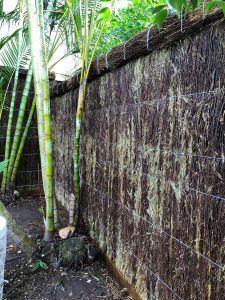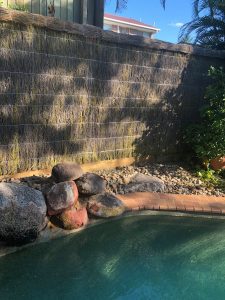Solomit prides itself on using environmentally friendly and carbon neutral materials in the manufacture of its products.
Brushwood Fencing
Maleleuca Broombush is a native plant that grows wild in desert areas of Australia. Maleleuca Uncinata as the variant of the species used in our Brushwood fences, is an erect multi-stemmed shrub, 1 – 3 metres in height, arising from a lingo-tuber; bark on the older stems is grey and papery. Leaves alternate, cylindrical or slightly flattened, 1.5-4 cm long, 1 mm diameter, deep-green, usually with a finely curved pointed tip. Flowers white to cream or yellowish, in dense globular heads, the stamens in bundles of 4 – 7 and much longer than the petals. Fruit an almost globular capsule, 2 – 3 mm diameter, borne in dense globular clusters of 10-15 capsules, the clusters 6 – 12 mm diameter. Flowering mainly spring – early summer.
Habitat: Deep sandy soils and red earths, usually in mallee communities; less commonly on gravelly ridges with loamy soils or around the edges of small sandy depressions.
Distribution: Mainly in the central – eastern part of Australia, less common in the south west; occurs also in the extreme north – western corner, where it grows in mulga country.
Broombush often occurs in dense monospecific stands within mallee communities where the surface soil is damp for several months during winter, in drier areas where the plants are scattered. Broombush has no pastoral value as it is not grazed by stock. It is used very successfully in the construction of brush fences, being easy to work and durable. Broombush is highly resistant to fire and shoots from ground level after burning. It is occasionally used as a garden plant.
Ref: Plants of Western NSW – Inkata Press
Regeneration – environmental sustainability & carbon capture
After the Broombush is harvested for use in the manufacturing process of brush fences, the plant regenerates quite quickly and re-grows to its former height, thereby absorbing carbon from the atmosphere.
In addition to this re-growth effect, by converting the Broombush into a product, the carbon storage effect of the process is not unsubstantial.
The Maleleuca Family
Melaleuca is a genus of plants in the myrtle family Myrtaceae. There are well over 200 recognized species, most of which are endemic to Australia. A few species occur in Malesia and 7 species are endemic to New Caledonia. The species are shrubs and trees growing (depending on species) to 2-30 m (6.6-98 ft) tall, often with flaky, exfoliating bark. The leaves are evergreen, alternately arranged, ovate to lanceolate, 1-25 cm (0.39-9.8 in) long and 0.5-7 cm (0.20-2.8 in) broad, with an entire margin, dark green to grey-green in colour. The flowers are produced in dense clusters along the stems, each flower with fine small petals and a tight bundle of stamens; flower colour varies from white to pink, red, pale yellow or greenish. The fruit is a small capsule containing numerous minute seeds.
Melaleuca is closely related to Callistemon, the main difference between the genera being that the stamens are generally free in Callistemon but grouped into bundles in Melaleuca. In the wild, Melaleuca plants are generally found in open forest, woodland or shrubland, particularly along watercourses and the edges of swamps.
The best-accepted common name for Melaleuca is simply melaleuca; however most of the larger species are also known as paperbarks, and the smaller types as honey myrtles. They are also sometimes referred to as punk trees.
One well-known melaleuca, the Ti tree (aka tea tree), Melaleuca alternifolia, is notable for its essential oil which is both anti-fungal, and antibiotic, while safely usable for topical applications. This is produced on a commercial scale, and marketed as Tea Tree Oil. The Ti tree is presumably named for the brown colouration of many water courses caused by leaves shed from trees of this and similar species (for a famous example see Brown Lake (Stradbroke Island)). The name “tea tree” is also used for a related genus, Leptospermum. Both Leptospermum and Melaleuca are myrtles of the family, Myrtaceae.
In Australia, Melaleuca species are sometimes used as food plants by the larvae of hepialid moths of the genus Aenetus including A. ligniveren. These burrow horizontally into the trunk then vertically down.
Melaleucas are popular garden plants, both in Australia and other tropical areas worldwide. In Hawai’i and the Florida Everglades, Melaleuca quinquenervia (Broad-leaved Paperbark) was introduced in order to help drain low-lying swampy areas. It has since gone on to become a serious invasive weed with potentially very serious consequences being that the plants are highly flammable and spread aggressively. Melaleuca populations have nearly quadrupled in southern Florida over the past decade, as can be noted on IFAS’s SRFer Mapserver
Traditional Aboriginal uses
Aboriginies used the leaves traditionally for many medicinal purposes, including chewing the young leaves to alleviate headache and for other ailments. The softness and flexibility of the paperbark itself made it an extremely useful tree to Aboriginal people. It was used to line coolamons when used as cradles, as a bandage, as a sleeping mat, and as material for building humpies. It was also used for wrapping food for cooking (in the same way aluminium foil is today), as a disposable raincoat, and for tamping holes in canoes. In the Gadigal language, it is called Bujor.



